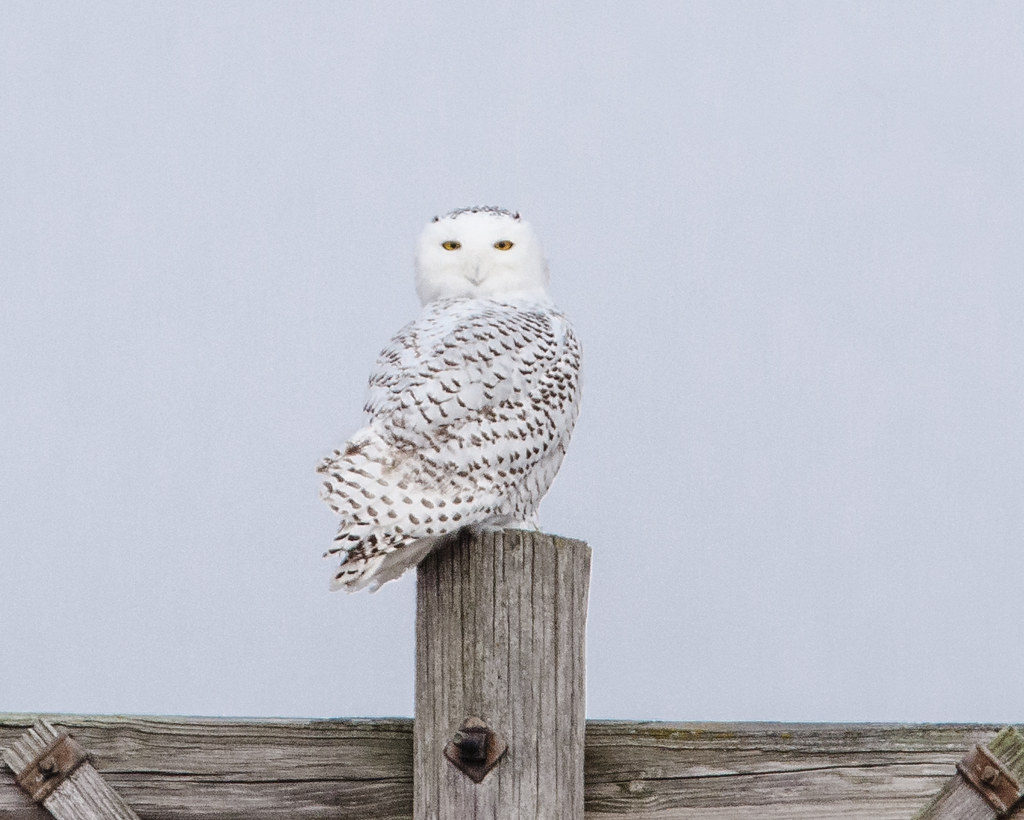 |
| Muskegon County, Michigan, November 30. Phonescoped by hand. |
Let’s get the background that we’re all familiar with out of
the way first.
The primary driver behind Snowy Owl (SNOW) irruptions well
south of their range is an abundance of owls caused by a highly successful
breeding summer. A good crop of lemmings to eat leads to lots of surviving
hatching-year owls. When winter comes, the owls move to pack ice and islands to
spend the winter eating ducks and waterbirds (primarily, not exclusively). As
this territory is limited, the extra juveniles are often forced out of range
and they head south. These are the owls (usually juvenile and usually in poor
health) that we see in the United States during a SNOW irruption. (For purposes
of clarity in this post, “United States” refers to the contiguous 48 states.)
The winter of 2011-12 saw a major irruption of Snowy Owls across
much of the United States and Canada. It was widespread from coast to coast and
particularly stunning in the interior where the invasion pushed all the way
into Texas. Two places that did not
see an irruption of SNOW in 2011-12 were Newfoundland and the Atlantic coast
south of Long Island.
 |
| 2011-12 Irruption. Note that Newfoundland and south of Long Island are sparse in owls. |
The winter of 2012-13 saw a predictable echo irruption
covering the core of the 2011-12 area minus the extremes of the range. Echo flights involve left over birds that survived their winter in the south, returned north, and head south again. It's common after a major irruption.
 |
| 2012-13 Echo Irruption |
With those data in hand, we could predict that lemming
numbers would not have recovered by now and most of the owl abundance from the
productive breeding season of 2011 had died off. There shouldn’t be any “extra”
owls to invade southward, therefore it would be a very weak year for SNOW in
the United States.
 |
| 2013 so far. Notice the purple in Bermuda! |
Obviously that prediction went down in flames. For reference, the map below shows what an "off" year should look like.
 |
| 2010-11 The winter before the huge irruption. |
We’re seeing a massive irruption of SNOW again, with numbers
rivaling or eclipsing 2011-12, except this time there is a significant
irruption in both Newfoundland and the Atlantic coast as far south as Cape
Romain, SC, but almost nothing is happening in the Plains or West.
As the action in Newfoundland heated up, I picked up this
anecdote from a conversation online: SNOW irruptions in Newfoundland have not
historically correlated with the widespread irruptions elsewhere in eastern
North America. Keep that in mind, and
let’s get back to this current event.
My North Carolina birding friend (and ex-patriate
Michigander) Cody Porter and I were dishing wild speculation about Snowy Owls
at each other and he pointed me to the folks at eBird suggesting invasions from
different parts of the arctic lead to different irruption patterns. In
particular, they were wondering about Greenland, given all of the birds on the
Atlantic coast and that one in Bermuda. (If you fly south from Greenland and
miss Newfoundland, Bermuda might be the next interesting thing you see.)
The problem I saw with that was that if Greenland lemmings
follow a different cycle than those in arctic Canada (which is a reasonable
assumption), then why have SNOW irruptions always followed a very typical 4-5
year cycle with little variation. You’d think these back-to-back irruptions
would happen more often.
One possibility is that oddly-timed irruptions DO happen
frequently and it’s just legend that the irruption cycle is so regular. I read
it plenty of times in 2011 and filed it away as gospel. Perhaps a dig through
Christmas Bird Count records could color this picture up a little.
 |
| Snowy Owl in Gratiot County, Michigan, December 8, 2013. Photo by Lansing, Michigan birder Greg Smith. Check out his other stuff here. |
There’s another possibility that I came up with which may be
a brilliant idea, the rantings of an ignorant dolt, or something that’s already
known.
Perhaps Greenland has an independent lemming cycle and the
owls from there do fly south at regular intervals. Most of the time they all
end up on Newfoundland, because that’s pretty much the first place they’d hit,
and there are generally plenty of good ducks for eating there. That explains
the Newfoundland irruptions that tend to not correlate with the continental
irruptions. This year, perhaps, was such an exceptionally good season in
Greenland, that Newfoundland has overflowed (200+ owls in a 40km strip on the
Avalon Peninsula!) and they’re headed down the eastern seaboard. And thus, no
owls in the Plains or West.
This would require several things for further investigation:
- CBC data for a century’s worth of SNOW irruptions. (Time consuming, but it’s there.)
- Knowledge of lemming populations in Greenland. (Someone has to know this.)
- Whether a preponderance of the owls on the Atlantic coast right now are Greenlandish in origin. (No way of knowing this that I’m aware of.)

No comments:
Post a Comment